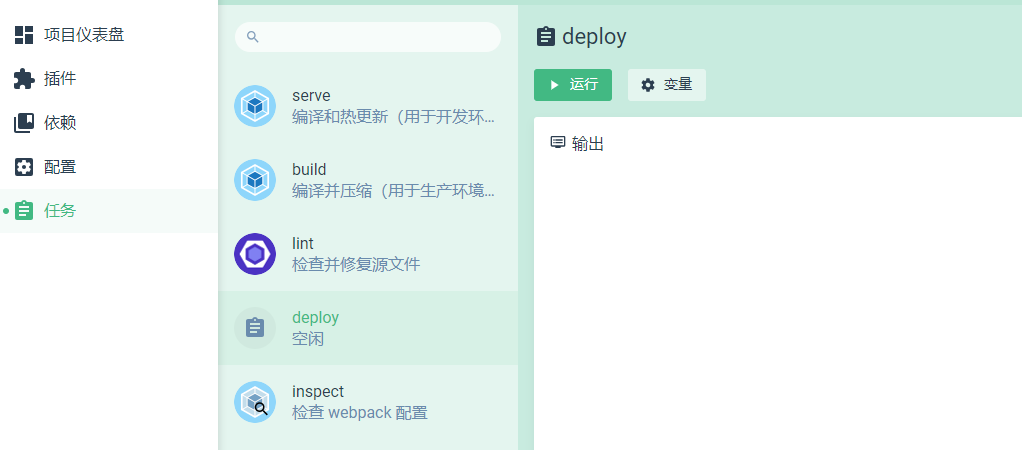Vue-CLI 3.x 部署项目至生产服务器
本文已同步到专业技术网站 www.sufaith.com, 该网站专注于前后端开发技术与经验分享, 包含Web开发、Nodejs、Python、Linux、IT资讯等板块.
本教程主要讲解的是 Vue-CLI 3.x 脚手架搭建的vue项目, 先构建生成dist文件(纯静态应用), 然后自动化部署到静态文件服务器 Nginx。
一、Nginx服务器文件的配置
server { listen 80; server_name www.xxxxxx.com;#生产环境 location / { root /usr/local/www/xxx_program/; index index.html; try_files $uri $uri/ /index.html; } } server { listen 80; server_name test.xxxxxx.com; #测试环境 location / { root /usr/local/www/xxx_program_test/; index index.html; try_files $uri $uri/ /index.html; } }
二、配置生产/测试环境 服务器SSH远程登陆账号
1. 在项目根目录下, 创建 .env 文件 (当前环境变量)
VUE_APP_SERVER_ID变量指代 当前需部署的服务器ID为0
VUE_APP_SERVER_ID=0
2. 在项目根目录下, 创建 deploy/products.js 文件
该文件功能如下:
(1) 读取env环境变量
const fs = require('fs')
const path = require('path')
// env环境变量的路径
const envPath = path.resolve(__dirname, '../.env')
// env对象
const envObj = parse(fs.readFileSync(envPath, 'utf8'))
const SERVER_ID = parseInt(envObj['VUE_APP_SERVER_ID'])
function parse (src) {
// 解析KEY=VAL的文件
const res = {}
src.split('\n').forEach(line => {
// matching "KEY' and 'VAL' in 'KEY=VAL'
const keyValueArr = line.match(/^\s*([\w\.\-]+)\s*=\s*(.*)?\s*$/)
// matched?
if (keyValueArr != null) {
const key = keyValueArr[1]
let value = keyValueArr[2] || ''
// expand newlines in quoted values
const len = value ? value.length : 0
if (len > 0 && value.charAt(0) === '"' && value.charAt(len - 1) === '"') {
value = value.replace(/\\n/gm, '\n')
}
// remove any surrounding quotes and extra spaces
value = value.replace(/(^['"]|['"]$)/g, '').trim()
res[key] = value
}
})
return res
}
(2) 定义多个服务器账号 及 根据 SERVER_ID 导出当前环境服务器账号
const SERVER_LIST = [ { id: 0, name: 'A-生产环境', domain: 'www.xxx.com', host: 'XX.XX.XX.XX', port: 22, username: 'root', password: 'xxxxxxx', path: '/usr/local/www/xxx_program/' }, { id: 1, name: 'B-测试环境', domain: 'test.xxx.com', host: 'XX.XX.XX.XX', port: 22, username: 'root', password: 'xxxxxxx', path: '/usr/local/www/xxx_program_test/' }, ] module.exports = SERVER_LIST[SERVER_ID]
三、创建自动化部署脚本 (使用scp2库)
在项目根目录下, 创建 deploy/index.js 文件
const scpClient = require('scp2')
const ora = require('ora')
const chalk = require('chalk')
const server = require('./products')
const spinner = ora('正在发布到生产服务器...')
spinner.start()
scpClient.scp('dist/', {
host: server.host,
port: server.port,
username: server.username,
password: server.password,
path: server.path
}, function(err) {
spinner.stop()
if (err) {
console.log(chalk.red(' 发布失败.\n'))
throw err
} else {
console.log(chalk.green(' Success! 成功发布到生产服务器! \n'))
}
})
四、添加 package.json 中的 scripts 命令, 自定义名称为 "deploy"
"scripts": { "serve": "vue-cli-service serve", "build": "vue-cli-service build", "lint": "vue-cli-service lint", "deploy": "npm run build && node ./deploy" }
五、执行部署任务
在项目根目录下 执行 npm run deploy命令, 或 使用 vue ui控制面板执行deploy任务, 即可自动打包并部署至线上服务器

备注:
要切换部署的服务器, 只需修改 .env文件中的服务器ID, 然后再执行deploy任务即可.
福利:
本文已同步到我的个人技术网站 IT干货-sufaith 该网站包括Python, Linux, Nodejs, 前端开发等模块, 专注于程序开发中的技术、经验总结与分享, 欢迎访问.





 浙公网安备 33010602011771号
浙公网安备 33010602011771号